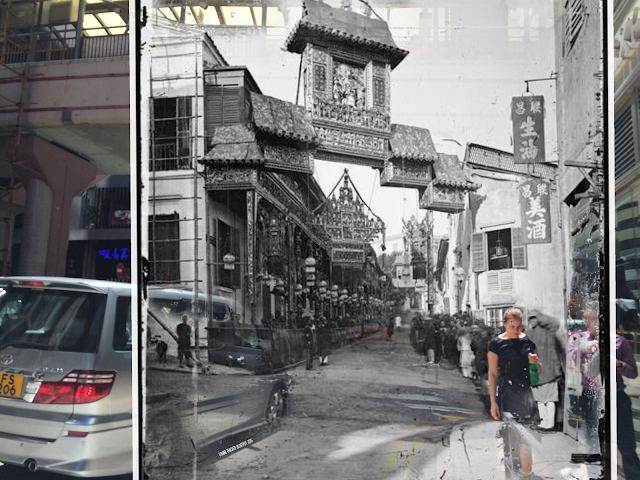麟檄士街上圍觀 | Crowd of Fascinated Onlookers on Lyndhurst Terrace
麟檄士街(Lyndhurst Terrace 擺花街 [1]) 上的花牌與燈飾,引來大批華人圍觀趁熱鬧。裝飾是為恭迎皇室成員愛丁堡公爵 (Prince Alfred, H.R.H. The Duke of Edinburgh) 而設,公爵於1869年11月由日本回程印度,順道訪港作短暫停留。龐大中式竹棚裝置,由眼前閣麟街 (Cochrane Street),一直伸延到街尾荷里活道(Hollywood Road),前後再立牌坊。靠近洋房,會見到沿途擺花點綴,再以藤蓆圍欄,屋前有巴斯族人(Parsee) 跟印裔警察在守候著,這是巴斯人的地方。維多利亞城(Victoria City),原是個不同族裔組成的商業社區,信奉古波斯拜火教 (Zoroastrianism 祅教) 的巴斯族人,有流散到孟買,隨英國人經商貿易。到香港開埠時,從事廣州貿易的巴斯商人,遷入落戶,於城內佔一席位 。The China Mail 1869年報導他們的巨型裝置時,有以下詳細描述:
This block [western end of Lyndhurst Terrace] extends from Mr. H.N. Mody's premises to that of Messrs. D. Ghoolamhoosan's, and include the premises of Mr. E.R. Belilios, R. Babibhoy and Mr. B. Ghoolamboosan. These firms have combined in one continuous illumination, covering half the Terrace. This is carried out with lanterns and is after the peculiar style of the Chinese, adopted by the natives on the occasion of the great Autumn Festival, and built entirely of bamboos it has a striking effect as the first of the kind over attempted externally in the Colony. The row is terminated on either end by archways in the same style of architecture as the frontage of the buildings, in which the Josses are supposed to protect the street at both ends. In order fully to carry out this novel ideas, a series of Chinese theatrical representations (in figures moved by live rats) are displayed under the verandah looking structure; and here are the principal chandeliers and pendant lamps, which light up the whole street. An improvement will be made by hanging of lamps on the outer front of the erection, which gives a fine effect to the peculiar Oriental appearance of the superficial decoration. Mica forms a great part of the reflecting portion of this general "get up," as it takes the place of glass. Flowers also (to carry out the general imitative effect) are ranged along the ground floor, as it were, of the verandah-like structure; and altogether one might be deceived into the belief that he was the first-class section of the Great Autumn Festival Exhibition The pillars at the door of each hong are beautifully carved out of bamboo, and are really gems of the description of carving; while their intensely Oriental flavor gives to them an individuality which is most marked and well worthy of special notice and admiration.
對面趁熱鬧的華人,衣着齊整,穿鞋的,明顯並非一般低下階層,似就近小商舖營業者。當時中環的華人主要來自東南沿海,省城、珠江三角、福建潮汕等地,男性為主,他們離開本鄉來到這異地,有一技之能,跟城中從事苦力的不同。
攝影師是著名的湯普森 (John Thomson 1837–1921),來自蘇格蘭,曾遊曆近東、印支,此刻他剛抵港落腳,經營攝影生意。攝影在1840年代出現,這門新興行業,像今日電腦產業,迅間流行,技術不斷突破。像湯普森的先行者,要穩定控制玻璃面上化學液體感光塗層,克服戶外氣候實景現場,構圖之餘,要透過鏡片密箱有效捕捉光影,將影像恒久印記於脆弱的玻璃底片,再行落皇后大道 (Queen's Road) 的工作室,安排印刷出版發行。他同時要兼顧科技、工藝、構圖藝術、行程規劃以至國際市場口味。
適逢盛事,湯普森發行一本紀念寫真集,相片亦有單張及其他書刊形式出現,他的商品於國際市場廣泛流傳。有相冊描述人群聚集,是為等候亮燈。但眼前街角這位華人,面向砵甸乍街(Pottinger Street),用手遮擋日曬,明顯正值中午或更早時份,所以,更大可能,是在等候巡遊,甚至是達官貴人到訪這家巴斯人。
新舊照合成時,原照片上下都裁走,原照是玻璃底片,不少花痕,但影像效果至今仍然清晰。在遠處背景,見到荷里活道及嘉咸街交界上石構洋房,以及路口三角位上冬青或榕樹,值得細味。今日街道依舊繁忙,閣麟街半山行人天橋,橫貫擺花街,在大樓及花牌前,為表現當年花牌,並無完全展示天橋。
巴斯人的兩層高石構住宅洋房,從湯普森另一照片中(圖1e),見到44-44A號街角一部分,觀察到立面原貌:兩三米高的窗戶、兩道要以梯級昇起的側門、門口街燈、樓上一列窄長的外懸木構露台、屋頂、簷篷、地面無舖頭。而另一張洋房的近照(圖1b),位置應為46號,見到大屋方形入口大門,見到裝飾細部,以及巴斯人面貌。留意左邊華人背向鏡頭。
由閣麟街至街尾靠南的一幅土地,業權原劃分為兩幅地段。巴斯人洋房橫跨今日44及46 號門牌。第一手業權人為蘇格蘭裔 Robert Strachan。他早年代理渣甸鴉片貿易,開埠後主理報章<Hong Kong Register>,市民名冊顯示50年後他經已離港。79年土地由阿美尼亞裔渣打爵士持有。一年後易手予祖籍波斯的 Hajee Mirza Abbokhassem, 84年有一間公司 Hajee Meerza Mahomed Ally & Co,應與此業主有關 。85年新業主將土地一部份分拆,售予一位華人[2],意味著該幢洋房至此經己拆卸。
至於後面緊接的一幅土地,開發時Strachan已經離港,當中覆蓋今日48及60號門牌。69年業權人為William Hudson Roper,在50年代中,Roper仍活躍於中國通商口岸。78年起本港猶太裔大商賈庇利羅士(The Hon. Emanuel Raphael Belilios, 加爾各答猶太族, 1837 – 1905)持有。96年陪審員名單,有Belilios & Co 外籍員工申報住所,就在48號。
 |
| Fig 1e: Facade of the east corner of the Parsee house, at 44-44A Lynhurst Terrace, ca 1870 (photo by J. Thomson. Source: Wellcome Images) |
擺花街原是山坡上一列眺望維港的臺(Terrace),背倚砵甸乍街這條山脊,是條短街。照片所見,已經是街道的一半。 今時今日,不少介紹擺花街的人,習慣開場白將擺花、洋嫖客、洋妓、紅燈區連繫一起,但究竟是指那段時期?持續有多久?經營模式?有幾大規模?整條街成行成市?單從1869年照片所見,該描述略嫌空泛,有待補充說明。
附註:
[1] 照片中路牌顯示,當年港府官方中文街道命名為麟檄士街,俗稱擺花街成為正式街道名,是近代的事
[2] 的近律師行檔案 DRS18(A-K) file no. 18/7
 |
| Fig 1g: West Side of Lyndhurst Terrace 1869-2015 (by Vincent Poon) |
 |
| Fig 1h: Street life in Lyndhurst Terrace, 2015 (by Vincent Poon) |







Comments
Post a Comment